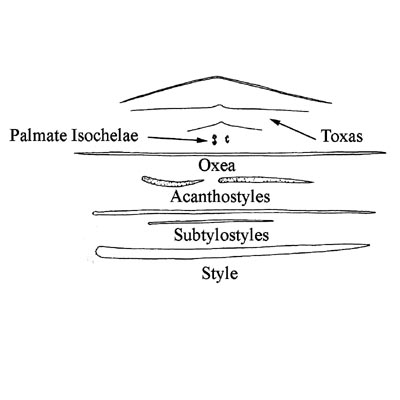[A]
Toxa 100-900 μm. |
 Green and Bakus, 1994
Green and Bakus, 1994 |
Sponge:
Small, encrusting 0.2 mm thick.
Consistency: fragile (pieces, damaged).
Color: Tan ? Alive.
Spicules: Megascleres:
(1) Subtylostyles with slightly acanthose heads:
290 -517- 870 um.
x 6.0 -9.0- 13.0 um.
(2) Styles with finely acanthose heads and shafts:
640 -696- 750 um.
x 23 -25- 26 um.
(3) Acanthostyle:
120 -138- 150 um.
x 10 -12- 16 um.
(4) Oxea:
1450 -1746- 2250 um.
x 5.0 - 6.0- 9.0 um.
Microscleres:
(1) Palmate Isochelae:
16 -16- 18 um.
(2) Toxa:
100 -374- 900 um.
Skeleton:
Authors state it was difficult to determine due to damage. Multispicular tracts of long diactins incorporated within plumose skeleton of monactins.
Distribution: Southern California, Santa Maria Basin.
Depth: Deep water, 92-100 m.
Note: Originally described from tiny, damaged fragments which included the very large Oxeas listed above. These may be a contaminant. Note also that in the same publication the authors described Hymedesmia (Holerodesmia) sp. A which has now been synonymized with Clathria (Microciona) sp. A. As a result, both of these are represented as sp. A. To avoid confusion we have designated these two species as sp. A-1 and species A-2. See page 156A.
|
|
|
Toxas to no greater than 350 μm.
|

|
|